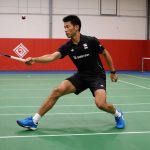Mastering Footwork: Strategies for UK Badminton Players to Enhance Court Speed and Agility
Understanding the Importance of Footwork in Badminton
Footwork is the backbone of any successful badminton player. It is the foundation upon which all other skills, such as hitting shots and maneuvering around the court, are built. Good footwork allows players to reach the shuttlecock quickly, position themselves optimally, and execute shots with precision and power.
In badminton, the court is relatively small, but the speed at which the shuttlecock travels is incredibly high. This means that players need to be highly agile and have excellent footwork to keep up. Here’s what Mark King, a seasoned badminton coach, has to say about the importance of footwork:
Also to see : Essential Legal Insights for UK Sports Agents Navigating International Contract Negotiations
“Footwork is crucial in badminton because it allows players to get into the right position to hit their shots. Without good footwork, you’ll struggle to reach the shuttlecock in time, and your shots will suffer as a result.”
Basic Footwork Drills for Badminton Players
To improve footwork, badminton players need to engage in regular drills that target different aspects of movement. Here are some basic drills that can help:
Also to see : Unlocking Winning Strategies: Innovative Approaches for UK Football Coaches to Enhance Game Plans
Forehand and Backhand Shuttles
- Drill Description: Start at the center of the court. A partner or coach hits a forehand shot to one side of the court. You need to move quickly to reach the shot and return it.
- Variation: Alternate between forehand and backhand shots to practice moving in different directions.
- Tip: Focus on quick, light steps and use your non-racket leg to push off and generate speed.
Net Shots and Drops
- Drill Description: Practice moving forward to the net to hit net shots and then quickly retreating to the back of the court to handle drop shots.
- Variation: Incorporate different types of shots, such as smashes and lifts, to simulate game scenarios.
- Tip: Keep your knees slightly bent and your weight evenly distributed between both feet for better balance.
Shuttle Runs
- Drill Description: Run from one side of the court to the other, mimicking the movement you would make during a game.
- Variation: Add changes of direction by incorporating zig-zag runs or figure-eight patterns.
- Tip: Use your arms to help with balance and generate additional speed.
Advanced Footwork Techniques
Once you have mastered the basic drills, it’s time to move on to more advanced techniques that can further enhance your court speed and agility.
Agility Training
Agility training is essential for improving your ability to change direction quickly and maintain speed. Here are some advanced agility drills:
- Cone Drills: Set up cones in a zig-zag pattern or a circle. Weave through the cones using different footwork patterns such as carioca drills (side-to-side shuffles) or high knees.
- Ladder Drills: Use a ladder to practice foot speed and agility. Drills such as ladder runs, lateral shuffles, and high knees can be very effective.
- Plyometric Training: Incorporate plyometric exercises like jump squats and box jumps to improve your explosive power and speed.
Court Coverage Strategies
Understanding how to cover the court effectively is crucial for maximizing your speed and agility. Here are some strategies:
- Center Positioning: Always try to return to the center of the court after hitting a shot. This gives you the best chance of reaching the next shot.
- Anticipation: Anticipate where the shuttlecock will go based on your opponent’s position and the type of shot they are likely to hit.
- Economical Movement: Use the most efficient path to reach the shuttlecock. Avoid unnecessary movements that waste time and energy.
Table: Comparing Different Types of Footwork Drills
| Drill Type | Description | Benefits |
|---|---|---|
| Forehand and Backhand Shuttles | Move to hit forehand and backhand shots from the center of the court. | Improves lateral movement and reaction time. |
| Net Shots and Drops | Practice moving forward to the net and retreating to handle drop shots. | Enhances forward and backward movement and net play skills. |
| Shuttle Runs | Run from one side of the court to the other, simulating game scenarios. | Increases overall court speed and endurance. |
| Cone Drills | Weave through cones in zig-zag or circular patterns. | Improves agility and quick changes of direction. |
| Ladder Drills | Use a ladder to practice foot speed and agility. | Enhances foot speed, agility, and coordination. |
| Plyometric Training | Incorporate jump squats, box jumps, and other plyometric exercises. | Increases explosive power and speed. |
Integrating Footwork into Your Badminton Training
To see significant improvements in your game, it’s essential to integrate footwork drills into your regular training routine. Here are some tips on how to do this effectively:
Create a Balanced Training Plan
- Ensure your training plan includes a mix of footwork drills, racket skills practice, and game scenarios.
- Allocate specific days for focused footwork training and other days for overall game practice.
Practice Under Game Conditions
- Practice your footwork drills in game-like scenarios. For example, have a partner hit shots while you move around the court.
- Incorporate different types of shots and game situations to simulate real matches.
Use Technology and Feedback
- Use video analysis to review your footwork and identify areas for improvement.
- Work with a coach or experienced player who can provide feedback on your technique.
Quotes from Experts and Players
- Mark King, Badminton Coach: “Footwork is not just about moving quickly; it’s also about moving efficiently. Good footwork saves energy and allows you to play at a higher intensity for longer periods.”
- Chris Adcock, Professional Badminton Player: “Footwork is something you need to practice consistently. It’s easy to neglect it, but it’s what separates the good players from the great ones.”
Practical Insights and Actionable Advice
Make Sure You Warm Up Properly
Before starting any footwork drills, make sure you warm up properly. This includes light cardio, stretching, and dynamic movements to prepare your muscles.
Focus on Good Technique
Always focus on good technique over speed. Poor technique can lead to injuries and will not improve your performance in the long run.
Practice Regularly
Consistency is key when it comes to improving footwork. Practice your drills regularly, even if it’s just for a few minutes each day.
Play Badminton with Different Opponents
Playing with different opponents can help you adapt your footwork to various playing styles and speeds. This will make you a more versatile and effective player.
Mastering footwork is a journey that requires dedication, consistent practice, and a well-structured training plan. By incorporating the drills and strategies outlined above into your badminton training, you can significantly improve your court speed and agility. Remember, good footwork is the foundation of a strong badminton game, and with the right approach, you can take your play to the next level.
Here is a detailed bullet point list to summarize the key points:
- Engage in regular footwork drills such as forehand and backhand shuttles, net shots and drops, and shuttle runs.
- Incorporate agility training using cones, ladders, and plyometric exercises.
- Practice court coverage strategies like center positioning, anticipation, and economical movement.
- Integrate footwork into your training plan with a balanced mix of drills and game scenarios.
- Use technology and feedback to review and improve your technique.
- Focus on good technique and warm up properly before each practice session.
- Practice regularly and play with different opponents to adapt to various playing styles.
By following these strategies and tips, you can enhance your badminton footwork, improve your overall performance, and become a more formidable opponent on the court.











